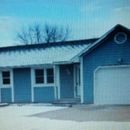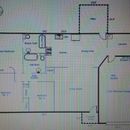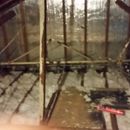Mold on the north side of the sheating in my attic
First let me apologize for the longwinded question. I purchased a house a while back it was an as-is purchase. We knew a fire had occurred several years back and seen what was presumed to be smoke damage in the attic.
The house had been re-wired, new sheetrock throughout kitchen etc. When we purchased the house the return air (duct work in crawl space) was not hooked up and this was one of the first things corrected.
Moving forward we installed new siding, did finish work inside, etc. My brother was installing the siding and said “you have mold.” I thought he was mistaken but it turns out he was right.
In a panic I called a mold testing company. They came out and got me even more freaked out, he went in to the attic and I asked if it was bad. He said it was severe and he would recommend removing and replacing the entire north side. He then said let’s go downstairs and talk, he started telling me about mold and ventilation, when we got to the moisture part of mold I pulled out my moisture decector and told him I went through the whole house and checked everything. He said he would re-check.
Their highest reading was 9% on the bathroom door casing, everywhere in the attic was 5.9 max. Humidity was 45% in the house and that testing right after we shut the door leading to the outside.
He performed an air quality test, then he performed one outside as a control, I asked him if he should of performed the control test on the north side of the house instead of the south side, he said it didn’t matter.
Another thing I thought was strange is he performed the indoor one in the front room under a running ceiling fan. Maybe I am being over analytical at this point, but as we continued to talk he discovered there is no wet wet wood in the attic or house and that the roof was two years old years old and if I have to replace it my brother is a 28 year roofer.
The tone of the conversation seemed to cage some. He then said I don’t have enough insulation in my attic it’s only abut and R19 and I need 12 more inches of white blown insulation and my soffit vents are blocked and it may be because of the return air plus the garage has a gable vent.
Here’s the question — lol — I have approximately 1,250 s.f. of attic floor space the ridge pole is approximately 6 foot high, there is mushroom vents (6) on the south side of the roof four soffit vents on the north side (because of garage and cover over porch) and about 6 soffit vents on the Southside soffit along with one gable vent on the the north face of the garage dormer. Should the gable vent be closed off?
Any other suggestions would be appreciated as I do know what to do. Thanks
GBA Detail Library
A collection of one thousand construction details organized by climate and house part












Replies
My apologies in my haste I forgot to mention we are located in Columbia Missouri region, also also due to the fact the house was winterized the walls were opened up in the bathrooms and we had some holes in the sheet rock so we could see behind the wall board and when we tore off the old siding on the north side we replaced some bad osb and nowhere did we see signs of mold.
Dysd,
There are lots of issues here. I'll just hit a few high points in response.
1. The way to tell if your roof sheathing is so rotten that it needs to be replaced is to go up in your attic and check it. Poke it with an awl to see if it is soft. If your brother is a roofer, he should be able to tell the difference between rotten sheathing and sound sheathing.
2. The most common cause of high attic moisture is a ceiling that leaks air. Here's what happens: warm, moist interior air leaks through ceiling cracks.The moisture condenses on cold surfaces (sheathing) during the winter. You'll see mold on the north side before you see it on the south side, because the sheathing on the south side is baked dry by the sun
3. To fix this problem, seal the air leaks. This article will tell you how to do the work: Air Sealing an Attic.
4. So-called "air quality tests" are bogus and tell you nothing.
5. If your house has only R-19 insulation in the attic, it's true that this isn't enough. After you have finished sealing all the leaks in your ceiling -- but not before -- you should add more insulation until you attain R-49. The added insulation won't help you with your mold problem, but it will reduce your energy bills.
-- Martin Holladay
Thank you for your response sir, we checked the OSB and all looked fine except the stainS of course. I stared sealing off the five penetrations coming through the ceiling (I used foam on some and caulk on others) and we plan on spraying cellouse insulation over the insulsafe (another contricting answer I get and confuses me). My initial question was should I seal off the gable vent on the front of the garage? The soffit vents stop at the porch on the front of the house abut they present on the backside of the house.
If regret even having to ask all these questions and take up everyone's time but I am getting to many "local expert" conflicting stories. Additional questions:
Add more of the white (insulsafe I think) or top off with cellouse?
How do I get the low side ventalation in the garage area?
Do I need to remove the existing insulation and put plastic down directly above my ceiling and then add insulation?
The reason I gave a brief description of what the mold guy said because after spending the money I feel very disturbed because I got the horror story of how bad things were than to be honest after we checked for moisture throughout the house and couldn't find any including the attic, it went from severe to its most important to do an air quality test because that's where I will be putting my family's health at risk.
Presumed mold remediation advise received:
Remove and replace all roofing material incLudington sheating
Spray with white vinegar wait 24 hours spray with white vinegar and coat bottom side of sheating with killz type product
Spray sheating with hydrogen peroxide and go about my business
Spray sheating with mule 20 borax and go about my business or coat with kilz type product
Soda blast (cost about 5k) and spray sealer on sheating
Fix ventilation and unsealed penetrations add insulation and do nothing because the roof is newer and as long as I keep the moisture down the attic is sealed.
Once again thank you for any advice my head is spinning like a top.
Sincerely
Is there any evidence of toxic mold? If you are dealing with regular mold, you could apply a mildicide. If there is a smell, you could use Kilz to encapsulate the problem area. Both these steps could be overkill if your sheathing simply has a little water staining.
Unfortunately I do not know if it is toxic I didn't have the money for the extra test ( I wasn't informed my two test for the inspection included the outdoor air control test) so the inspector said he would go with the indoor one since that's where i will be putting my family. As mentioned the entire north side and the dormer over the garage are the worse. The south side have some in between a couple of joist. I have attached some pictures. I will post what I think was the problem.
The photo with the white is where I sprayed peroxide on it
Ok, I think I may now know what it was caused from but firat let me start out by saying thank you to all the proffesionals that are selfless enough to take the time out of their lives to help and empower us.
I pulled the soffit vents off they were blocked with insulation, the screens were blocked with dust/debris so not only was there ristricted air floor the bathroom fans that are ran to the soffit couldn't possibly be letting the air out plus restricting the air flow in. Other than the obvious of not enough insulation, from the generous information I have received my air flow is unbalanced. I have 8 ridge vents on the south side, 4 soffit vents on the south side, two soffit vents on the north side and one soffit vent on the eave of the garage dormer (gable vent on garage was covered with plastic).
Any suggestions on how to correct this? I started sealing off any penetrations going through the ceiling and will re-route the bathroom exhaust fans out the roof with rigid pipe (my brother say flex will work since it's on 2 foot runs).
Photos of the vents and attic
Soffit and ridge vent pictures
Read this article by the folks at Building Science Corporation: https://buildingscience.com/documents/reports/rr-0211-mold-causes-health-effects-and-clean-up/view
I think it will help you to understand how to tackle this issue without unnecessary expense.
Great article and thank you, I am starting to feel a little better about this whole situation and a little worse about the mold inspector. I took Martins advice and checked the OSB with a awl and while we could get the tip to stick in it wasn't real spungy. At this point I think I am going to spray the surface with dist ells white vinegar, then wipe down with mule 20 borax, then paint with mold control paint. Finish sealing off all penetrations, run bathroom vents outside through roof, add more insulation. With regards to ventalation; add two more soffit vents to north side ( this will make 4 on the north and 4 on the south) leave the 1 soffit vent at garage dormer. This will give me 9 soffit vents and 8 ridge vents. The gable vent is still in question as the soffit vent on the dormer will do its part but without it the air will have to build up to move through the dormer. This is the area I am most confused about because it's over the at ached garage and there is a ridge vent on the south side but that area is where the garage wall (door to enter the house in to utility room with furnace ) is located over.
Dysd,
1. It sounds like you have discovered that your bathroom exhaust fan is vented to your attic. That is a key part of your puzzle. It is essential to correct this ducting error. The fan has to be vented to the exterior.
2. In Comment #3, you told us that you sealed "the five penetrations coming through the ceiling." That's a good start -- but remember, there are probably lots of ceiling leaks (not just the five penetrations). A major route for air leakage is the crack between drywall on partition walls and the partition top plates, for example. These cracks can be sealed from the attic side, but it's necessary to remove the insulation to expose the top plates to do this work.
Sealing all of these leaks is essential if you want to solve this problem.
3. You seem to be focused on attic venting issues. I think that's a mistake. Problems like yours are usually unrelated to attic venting. Even if your attic venting is unbalanced, that's not the problem. The problem is the moisture that you are introducing into your attic. If you can stop introducing moisture, you'll fix the problem. That means that you need to re-route the bath exhaust fan and seal the ceiling leaks.
To learn why attic ventilation doesn't matter very much, read this article: All About Attic Venting.
-- Martin Holladay
Thank you Martin, the bathroom exhaust fans are routed to the soffit but I don't think that is neccessarily considered out. I will do as you mentitled and sell off all the areas. Is it bethere to have plywood covering my attic floor?
Are you sure the roof is not leaking?
But I'm pretty sure you'll need a new roof + new OSBs.
Anon,
If the OSB is sound -- simply discolored by mold -- there is absolutely no reason to replace the OSB and the roofing.
-- Martin Holladay
100% positive the roof is not leaking, we had 5+ inches of rain over a 7 day period, the mold inspector checked the framing members and osb for moisture the day after we had another 1 inches of rain. All interior ceilings are freshly painted (no stains), the insulation is not wet, the only place it packed if where people have been walking, moved insulation away from all penetrations to inspect top side of sheetrock for mold/moisture and neither existed in all areas checked. I am purchasing a humidity gauge today to install in the attic to monitor the humidity levels. I am no expert nor am I even versed in this subjet but I have spent the last week diligently educating myself on all facets and though I am probably wrong and hyper focusing I believe that the condition occurred because the bathroom vents were routed to blocked soffit vents (insulation and dust latent screens), the previous occupants lived there for an unknown period with the return air not hooked up in 1/3 rd of the house, the house was winterized by the bank and the heat turned on with return air being corrected, previous roof leaks being why the roof is only 2 years old (confirmed with neighbors), more soffit vents on the hottest side of the house and only two on the north side (sorry Martin but there is so many conflicting information on this subject, I figure better safe than sorry), unsealed parting walls etc (as Martin pointed out) and lastly inadequate amount of insulation. I have also decided mold inspectors are bogus and since the epa does not have standards they cross a moral boundary by telling home owners what is and what is not safe and inadvertently cause home owners to spend unnecessary money. I just read an article where building materials that were being installed during construction all had the presence of mold while being installed. I wish for everyone's sake we had cut and dry factual data for homeowners, I see why so many people loose their house taking out unnecessary second mortgages, forfeit them to banks because they can't afford repair and are too scared to be in their own homes and loose money on the sale of their home due to opinions of home inspectors based on a couple of extreme conditions they read about and then they apply the content of that article to everything that look at. I definitely could not have made it through this with my sanity without all the support of you all, and I look forward to keep using everyone as a resource as I navigate through this rehab nightmare. Thank you all!
My apologies for all the grammatical errors, I meant to state the bank had the home winterized without correcting the return air and the house was still being heated.
Do you own or have access to the IR imaging camera used to take the roof deck pics, it can be useful in chasing down some of the less obvious air leaks at the ceiling plane. Depressurize the house with window fans or box fans mounted in windows (multiples, if you have them), and scan the ceiling with the camera. Leak points and thermal bridges (such as the joists) will show up in the IR pictures if the attic air temp is significantly different (higher or lower) than the room air temperature.
It sounds as if you may have more ridge vent area than soffit free air vent area. If that's the case it will increase the stack effect drive that is pulling air from the rooms into the attic in winter. Ideally more than half of the vent area would be at the eaves. say a ratio of 60% eaves, 40% ridge. A gable vent short-circuits the eave ventilation volumes, providing less drying air at the insulation chutes, and it may be worth blocking that off, while adding more eave ventilation.
https://www.greenbuildingadvisor.com/blogs/dept/building-science/lstiburek-s-rules-venting-roofs?page=1
https://buildingscience.com/sites/default/files/migrate/pdf/PA_Crash_Course_Roof_Venting_FHB.pdf
Dan thank you for your response. Yes, my brother let me borrow his FLIR 1 (hooks up to phone) there is no emmisvisity setting but you can adjust the surface finish type (gloss, Matt etc). Yes I have 8 ridge vents on the south side of the roof. My only concern with closing off the gable vent was, it is over the unconditione garage dormer but there is a soffit vent there. That end of the house is unconditioned garage and conditioned utility room, there is a ridge vent over the conditioned part. This evening I will take the previously attached drawing and mark all the locations of the ridge and soffit vents but leaving it open was my concern because the dormer area is one of the worse spots.
Dysd,
Q. "I wish for everyone's sake we had cut-and-dried factual data for homeowners."
A. Such an information source exists. It is called Green Building Advisor, and you found it.
-- Martin Holladay